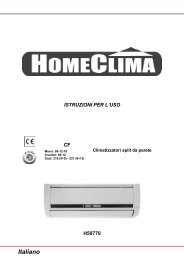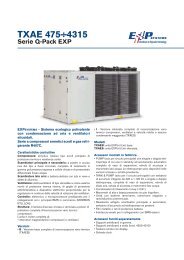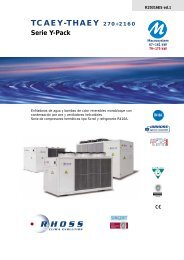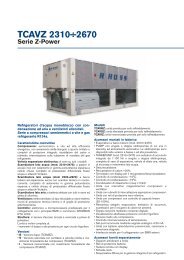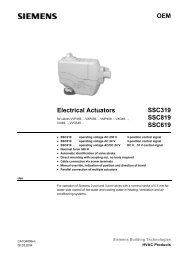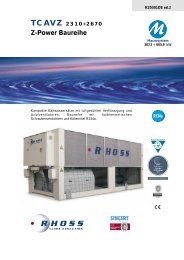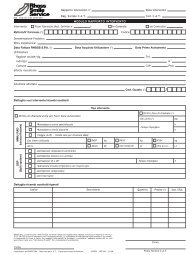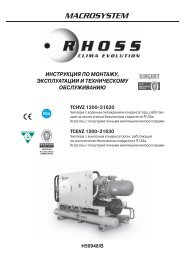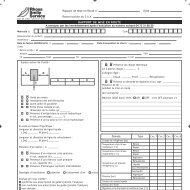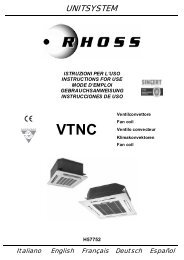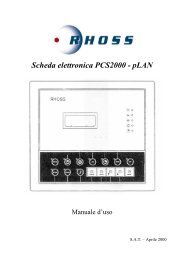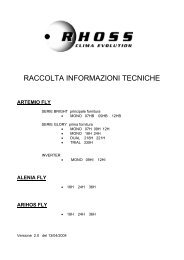tcaes 230÷4160 thae - Rhoss
tcaes 230÷4160 thae - Rhoss
tcaes 230÷4160 thae - Rhoss
Create successful ePaper yourself
Turn your PDF publications into a flip-book with our unique Google optimized e-Paper software.
SECTION II: INSTALLATION AND MAINTENANCE<br />
II.3.3<br />
STATUS INDICATOR LEDS<br />
○ COMPRESSOR STATUS LED<br />
• Off: the compressor is not running.<br />
• On: the compressor is running.<br />
• Flashing fast: delay timer operation.<br />
• Flashing slowly: defrosting.<br />
○ EVAPORATOR HEATING ELEMENT LED<br />
• Off: the heating element is disabled.<br />
• On: the heating element is activated.<br />
II.3.4 STARTING AND STOPPING THE MACHINE<br />
START UP AFTER LONG PERIODS OF<br />
INACTIVITY<br />
IMPORTANT!<br />
Machine commissioning or the first start up must<br />
be carried out by skilled personnel authorised by<br />
RHOSS, and anyway qualified to work on this type<br />
of product.<br />
○ Always act on the main disconnecting switch to disconnect the unit<br />
from the mains power supply before carrying out any maintenance work<br />
or inspections on the appliance.<br />
○ Check the following before starting up the unit:<br />
The electricity power supply must comply with the specifications on the<br />
data plate and/or the wiring diagram (L1-L2-L3 + NEUTRAL threephase<br />
power supply) and it must fall within the following limits:<br />
• Power supply frequency variation: ±2 Hz.<br />
• Power supply voltage variation: ±10% the rated voltage.<br />
• Imbalance between the power supply phases: < 2%.<br />
Electrical connections must be carried out in compliance with the<br />
regulations in effect in the place of installation and with the indications<br />
on the wiring diagram provided with the unit.<br />
The installer is responsible for sizing the power supply cables.<br />
IMPORTANT: before connecting the main L1-L2-L3+N power<br />
supply cables to the terminals on the main disconnecting switch,<br />
make sure they are in the correct sequence.<br />
• Access the control panel and make sure the power supply terminals<br />
and contactors are secured tightly (they may have become loose during<br />
transport, which could lead to malfunctions);<br />
• make sure that the oil level in the compressors reaches at least half<br />
way up the sight glass;<br />
• make sure the delivery and flow lines on the water system are<br />
connected according to the arrows next to the water exchanger inlet<br />
and outlet;<br />
• make sure the condensing coil is well ventilated and clean.<br />
○ On all units, the microprocessor board starts up the compressors 3<br />
minutes after the machine was last stopped.<br />
○ The appliance may now be switched on by acting on the main<br />
ON/OFF switch on the microprocessor control user interface panel,<br />
located on the control board. Any malfunctions are immediately<br />
displayed on the control panel by way of the alarm signals.<br />
II.3.4.1 Daily shutdown<br />
Daily shutdown can be controlled by acting on the ON/OFF key on the<br />
user interface panel or from a user remote ON/OFF control which can<br />
be inserted on the unit by following the indications in the wiring<br />
diagrams.<br />
This ensures the power supply to the compressor sump heating<br />
elements.<br />
II.3.5 CALIBRATING SAFETY AND CONTROL<br />
DEVICES<br />
The units are factory tested, where they are also calibrated and the<br />
default parameter settings are inserted. These guarantee that the<br />
appliances run correctly in rated working conditions (see “SAFETY<br />
COMPONENT CALIBRATION SETTINGS”).<br />
• The circuit sizing of the electronic and electromechanical<br />
components employed are indicated in the wiring diagram enclosed<br />
with the unit.<br />
Safety component calibration settings Enablement<br />
High pressure switch (PA)<br />
Low pressure switch (PB) (TCAE-<br />
TCAES)<br />
Low pressure switch (PB) (THAE-<br />
THAES)<br />
Water differential pressure switch<br />
Electronic board parameters<br />
Summer working temperature setting<br />
Winter working temperature setting (THAE-<br />
THAES)<br />
28,5 bar<br />
2,0 bar<br />
0,7 bar<br />
0,09 bar<br />
Reset<br />
18,5 bar -<br />
MANUAL<br />
3,5 bar –<br />
AUTOMATIC<br />
2,2 bar –<br />
AUTOMATIC<br />
0,11 bar -<br />
AUTOMATIC<br />
Default setting<br />
9.5°C (230÷260)<br />
8°C (470÷4160)<br />
42.5°C (230÷260)<br />
44°C (470÷4160)<br />
Working temperature differential<br />
1.3°C (470÷4160)<br />
2.6°C (230÷260)<br />
Antifreeze temperature set point 3°C<br />
Maximum defrosting time (THAE-THAES)<br />
10 min<br />
Minimum time between two consecutive<br />
defrosting procedures (THAE-THAES)<br />
40 min<br />
Antifreeze temperature differential 8°C<br />
II.3.6 ALARM TABLE<br />
The control board displays the alarms referred to in the “TYPE OF<br />
ALARM TABLE”. Alarms are reset by acting on the RESET key on the<br />
board after the problem has been identified and eliminated.<br />
Alarm Alarm description Reset<br />
E01 High pressure 1 alarm MANUAL<br />
E02 Low pressure 1 alarm MANUAL<br />
E03 Compressor 1 thermal overload MANUAL<br />
E04 Fan thermal overload alarm MANUAL<br />
E05 Antifreeze block alarm MANUAL<br />
E06 ST2 sensor malfunction AUTOMATIC<br />
E07 ST3 sensor malfunction AUTOMATIC<br />
E13 Compressor 2 thermal overload MANUAL<br />
E21 High pressure 2 alarm MANUAL<br />
E22 Low pressure 2 alarm MANUAL<br />
E23 Compressor 3 thermal overload MANUAL<br />
E27 ST6 sensor malfunction AUTOMATIC<br />
E33 Compressor 4 thermal overload MANUAL<br />
E40 ST1 sensor malfunction AUTOMATIC<br />
E41 Water differential pressure switch alarm MANUAL<br />
16



